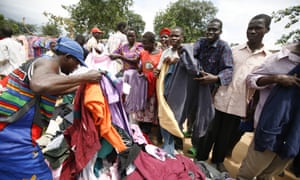
Increasing the cost of clothing will hit east Africa’s low-income consumers, but the shock effect could be reduced if a ban was imposed gradually. Photograph: Dan Chung for the Guardian
By Andrew Brooks
Across the African continent second-hand clothes from developed countries are a mainstay of many informal traders, dominating local market stalls. East Africa alone imported $151m of second-hand clothing last year, most of which was collected by charities and recyclers in Europe and North America.
In February, however, the East African Community (EAC), an intergovernmental organisation, proposed a ban on imported used clothes and shoes. The aim is to encourage local production and development within member countries: Burundi, Kenya, Rwanda, Tanzania and Uganda.
In the 1970s, east Africa’s clothing manufacturing sector employed hundreds of thousands of people, but when the debt crisis hit local economies in the 1980s and 1990s, local manufacturing struggled to compete with international competition and factories were forced to close. Today, the small sector remaining is geared towards production for exports.
Many orthodox economists disagree with banning imports because it goes against the principles of free trade. Rather than having the freedom to choose imported used clothing, east African consumers will have to buy higher priced local goods or new clothes imported from Asia.
Increasing the cost of clothing will hit east Africa’s many low-income consumers, but the shock effect could be reduced if a ban was imposed gradually. If a tax on used clothing imports was introduced before an outright ban, this could subsidise local production and increase local manufacturing capacity.
A revitalised local market would ultimately boost the EAC’s economy by providing more jobs than the second-hand sector while retaining money that currently goes to Europe and the US to pay for second-hand imports.
It is important to emphasise, however, that turning off the supply of used clothing alone will not enable the growth of local manufacturing. The proposed ban on imports doesn’t include new clothing imports from outside the EAC. While foreign garments will be more expensive than used clothes, they are likely to be cheaper than locally manufactured clothes as has been found in South Africa.Efforts to ban used clothing imports are therefore unlikely to be beneficial for the local economy unless there are similar controls on new clothing imports. This would require the strengthening of customs and borders.
Clothing manufacturers in east Africa face other challenges. If countries such as Kenya are to revitalise their clothing industry, which once employed an estimated 500,000 people and nowonly has around 20,000 workers, then the EAC needs to promote industrial policies.
These might include improving communication, transport infrastructure and power supplies to enhance distribution and avoid delays in production; providing tax relief for factories; and offering export incentives. Links could also be established with east Africa’s cotton growing sector to improve its sustainability and help ensure a reliable local supply of raw materials.
Successful nations such as China and South Korea did not emerge from poverty by becoming dependent on exports from the west. Instead they protected domestic markets. Second-hand clothes may be more affordable, but trading in them reinforces an unequal relationship between haves and have-nots in the global economy.
If east African leaders want to do more than maintain the status quo they need to take bold decisions, even if this means sometimes taking decisions that might be unpopular with international advocates of free trade. The intention of the ban and the goal of promoting industrialisation in the east African region is commendable, but for it to be successful more needs to be done to support industry and to break the cycle of dependency.
Dr Andrew Brooks is the author of Clothing Poverty: The Hidden World of Fast Fashion and Second-hand Clothes
Source: The Guardian


